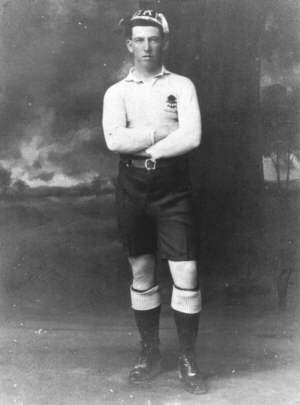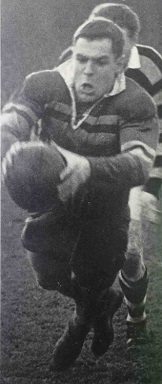Related Research Articles

The Australia men's national rugby union team, nicknamed the Wallabies, is the representative men's national team in the sport of rugby union for the nation of Australia. The team first played at Sydney in 1899, winning their first test match against the touring British Isles team.
John Edward Thornett, MBE was an Australian rugby union player, who played 37 Tests for Australia between 1955 and 1967 and made an additional 77 representative match appearances. He captained Australia in 16 Test matches and on an additional 47 tour matches on the eight international rugby tours he made with Wallaby squads.
Kenneth William Catchpole was an Australian rugby union footballer. A state and national representative half-back, he played twenty-seven matches for Australia, thirteen as captain. Catchpole rose through the ranks at the Randwick club as a young man, before making his debut for New South Wales at only 19 years of age, then captaining Australia at age 21. He is considered one of Australia's greatest rugby scrumhalves.
John Brass is an Australian former rugby union and rugby league footballer – a dual-code international. He made twelve international representative rugby union appearances with the Wallabies from 1966 to 1968 and six representative rugby league appearances for the Kangaroos in 1970 and 1975, as national captain on one occasion.
Kenneth Howard "Killer" Kearney was an Australian rugby footballer – a dual-code international player – and a rugby league coach. He represented the Wallabies in seven Tests, and the Kangaroos in thirty-one Test matches and World Cup games. He captained Australia in nine rugby league Test matches in 1956 and 1957. He was a hooker and captain-coach with the St. George Dragons in the first half of their eleven-year consecutive premiership winning run from 1956 to 1966. He is considered one of Australia's finest footballers of the 20th century.

Christopher Hobart McKivat was an Australian rugby union and rugby league player – a dual-code rugby international. He represented the Wallabies in over 20 Tests and tour matches from 1907 to 1909 and the Kangaroos in 5 Tests from 1910 to 1912. He is unique in Australian rugby history as the only man to captain both the national rugby union and rugby league teams. Following his playing career, he became the most successful coach of North Sydney in the club's history.
Ronald James Lisle was an Australian rugby union and rugby league player and a dual code rugby international. He represented the Wallabies in 4 tests in 1961 and the Australia national rugby league team in 13 matches on the 1963 Kangaroo tour.

Jack 'Darb' Hickey was an Australian rugby union and pioneer professional rugby league footballer and represented his country at both sports. He was one of Australia's early dual-code rugby internationals. He competed in the 1908 Summer Olympics in rugby union and was notable for scoring the first ever try for the Australian national side in a rugby league test match.

Ken Thornett, also known by the nickname of "The Mayor of Parramatta", was an Australian rugby league fullback. He represented the Kangaroos in twelve Tests during 1963 and 1964 and on the off-season Kangaroo Tour.
Ewen James Andrew McKenzie is an Australian professional rugby union coach and a former international rugby player. He played for Australia's World Cup winning team in 1991 and earned 51 caps for the Wallabies during his test career. McKenzie was head coach of the Australian team from 2013 to 2014. He has coached in both southern and northern hemispheres, in Super Rugby for the Waratahs and Reds, and in France at Top 14 side Stade Français. During his playing days he was a prop and, in a representative career spanning from 1987 to 1997, he played nine seasons for the NSW Waratahs and two for the ACT Brumbies.
Arthur John Michael "Mackker" McCabe was an Australian rugby union and pioneer professional rugby league footballer. He represented for Australian in rugby union at the 1908 Summer Olympics.

Rugby union in Victoria describes the sport of rugby union being played and watched in the state of Victoria in Australia. The code was first introduced some time between the 1850s and 1880s but remained a minor sport played primarily in the private schools and amongst interstate expats. This has changed, particularly since the professionalisation of the game in the mid 1990s.

Richard Murray Tooth was an Australian rugby union footballer of the 1950s. He represented the Wallabies in ten Test matches and nineteen total appearances and was Australian captain on two occasions. He resided at St Andrew's College while studying at Sydney University. His club rugby was played with the Sydney University Football Club and later with Randwick in the Shute Shield. He practised as an orthopaedic surgeon and was a sports medicine pioneer.
Between October 1966 and March 1967 the Australia national rugby union team – the Wallabies – conducted a world tour on which they played five Tests and thirty-one minor tour matches. Under the captaincy of John Thornett they toured UK, Ireland, France and Canada winning nineteen matches, losing fourteen and drawing three. At one stage they failed to win in four successive matches although in the Test match against England they gave the home side its heaviest defeat in 16 years. The tour marked the climax of the successful "Thornett Era" of Australian Rugby, buoyed by the leadership skills of skipper John Thornett and the outstanding abilities of greats of the game like Ken Catchpole, Peter Johnson and Rob Heming. Dick Marks and Peter Crittle also toured and would later become among the most influential administrators of Australian rugby.
John Noel Brian Hipwell was an Australian national representative rugby union player who played and captained the Wallabies. He played the majority of his career at scrum half and his representative career spanned 14 seasons from 1968 to 1981.

Peter George Johnson was an Australian international rugby union player. He enjoyed a long state and international career throughout the 1960s and made 92 national appearances for his country. He captained the Australian side in five Test matches.
Richard James Pickett Marks is an Australian former rugby union footballer, noted rugby administrator and author. He played 17 Tests for Australia between 1962 and 1967, and was a captain of Queensland, for whom he played from 1962 to 1972. He served as national coaching director from 1974 to 1995, and was a leading figure in lifting the standard of Australian rugby. He also served on the Board of Queensland Rugby and was an inaugural member of rugby's International Technical Committee and drafter of the Game’s Charter. He received the Joe French Award for his contributions to Australian rugby in 2014, and remains active in debates on governance of Australian rugby. In 2020, he was inducted into the Queensland Sport Hall of Fame. In 2024, he was honoured with a Member of the Order of Australia award for significant service to rugby as a player, coach, and administrator. He is the grandfather of Queensland Reds player Curtis Browning.
Robin John Heming was an Australian Lock/ No.8 rugby union player who played 21 tests for Australia between 1961 and 1967. Born in Namatanai in New Ireland off the then Australian Territory of New Guinea. He was educated at North Sydney Boys High School and qualified as an optometrist at what is now The University of New South Wales. He practised for many years on The Corso at Manly.
Richard Lewis Taylor was an Australian rugby union and rugby league player.
John Allan Francis is an Australian former international rugby union player.
References
- ↑ "Dick Webb signs big contract". The Age . 20 March 1967.
- ↑ "Richard Webb". classicwallabies.com.au.
- ↑ "Wallabies lose heavily to Combined side". The Sydney Morning Herald . 12 January 1967.
- ↑ "Webb threat to Cardy's place". The Sydney Morning Herald . 27 January 1967.
- ↑ "Dick Webb - Playing Career - RLP". www.rugbyleagueproject.org.